Art
What a Tiny Masterpiece Reveals About Power and Beauty
Published: 01 January 2024
User Rating: 5 / 5
Shahab-ud-din Muhammad Khurram (January 5, 1592 - July 31, 1658) was born in Lahore, in modern-day Pakistan, and was the third son of Prince Salim (later known as 'Jahangir'). His mother was a Rajput princess from Marwar called Princess Jagat Gosaini. The name "Khurram" (joyous) was chosen for the young prince by his grandfather, Emperor Akbar, with whom the young prince shared a close relationship Evidence from the reign of Shah Jahan states that in 1648 the army consisted of 911,400 infantry, musketeers, and artillery men, and 185,000 Sowars commanded by princes and nobles. His cultural and political initial steps have been described as a type of the Timurid Renaissance, in which he built historical and political bonds with his Timurid heritage mainly via his numerous unsuccessful military campaigns on his ancestral region of Balkh. In various forms, Shah Jahan appropriated his Timurid background and grafted it onto his imperial legacy.

Shah Jahan on Horseback During his Youth
During his reign the Marwari horse was introduced, becoming Shah Jahan's favorite, and various Mughal cannons were mass-produced in the Jaigarh Fort. Under his rule, the empire became a huge military machine and the nobles and their contingents multiplied almost fourfold, as did the demands for more revenue from their citizens. But due to his measures in the financial and commercial fields, it was a period of general stability—the administration was centralized and court affairs systematized.
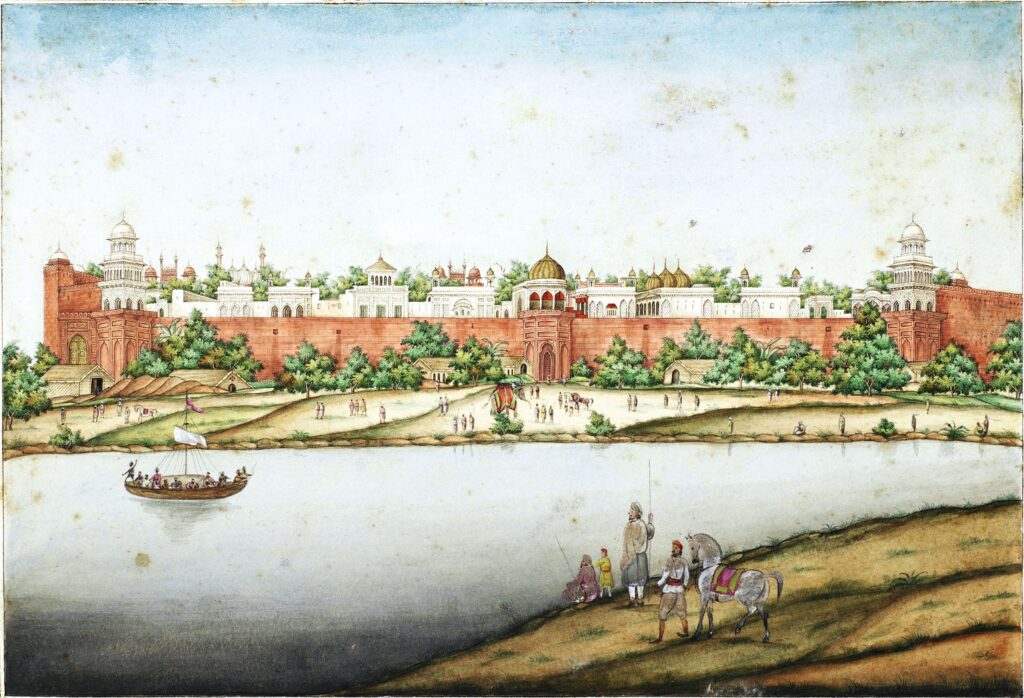
Ghulam Ali Khan Red Fort
The Mughal Empire continued to expand moderately during his reign as his sons commanded large armies on different fronts. India at the time was a rich center of the arts, crafts and architecture, and some of the best of the architects, artisans, craftsmen, painters and writers of the world resided in Shah Jahan's empire. According to economist Angus Maddison, Mughal-era India's share of global gross domestic product (GDP) grew from 22.7% in 1600 to 24.4% in 1700, surpassing China to become the world's largest.
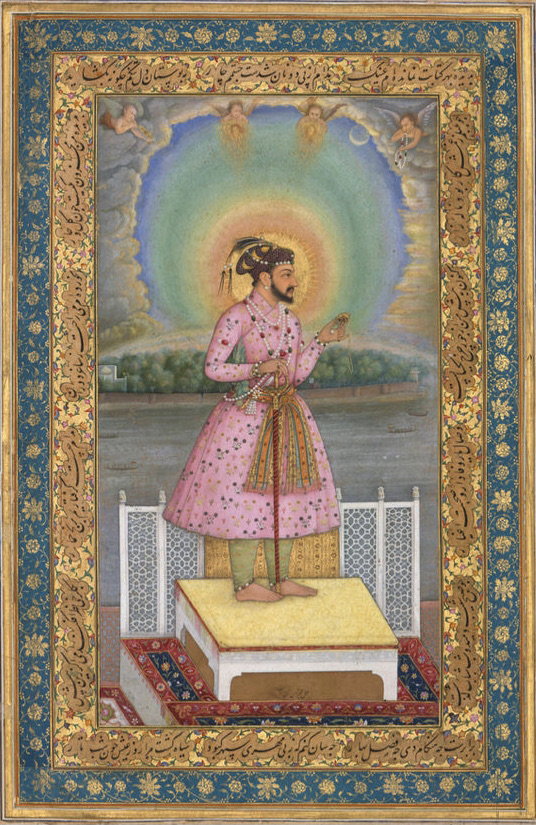
Chitarman, “Shah Jahan on a Terrace, Holding a Pendant Set With His Portrait,” Recto: 1627-28 and Verso: circa 1530-50/Metropolitan Museum of Art
Meet Shah Jahan, the Mughal emperor. His regnal name translates as “King of the World,” and he was exaggerating only slightly. Four centuries ago, mighty crosscurrents of religion and culture flowed into a new Indian art. It was courtly and refined, but also eye-poppingly luxuriant. The Mughal empire was the richest polity of its age, and a powerhouse of global trade. It reached its zenith under Shah Jahan, who laid out incalculable sums on architecture, gardens, jewelry — and paintings. He commissioned this one right around the time he took the throne, at 36. It was painted by an artist called Chitarman. The painting itself is only about eight inches tall, and surrounded by calligraphy and flowers of gold. The whole sheet is smaller than a tabloid newspaper. You will not, however, find it with the bulk of the museum’s Indian art. This painting, and the album it comes from, are in the Islamic collection; it’s a Muslim masterpiece made 2,500 miles from Mecca. It’s a lush life. Beyond the horizon the empire stirs; here we are all dressed up, in extravagant solitude. We’ve come to the north of India. It feels like summer; flat-bottomed boats ply the Yamuna River. A few small birds flutter through the dry air. Also flying creatures of a more celestial order. And it’s all the province of one man. His authority comes through in his bearing, and in a beauty that’s literally incandescent. So bright that even the clouds part to let him shine. Mughal miniatures are unbelievably detailed, but that’s not what I love most about them. What I love is their profound cosmopolitanism: Hindu, Islamic and even Christian motifs, blended into images of the highest prestige. Within the details of this miniature lies a master class in the political uses of cultural hybridity. And the uses of something else too: dumbfounding, superhuman beauty.
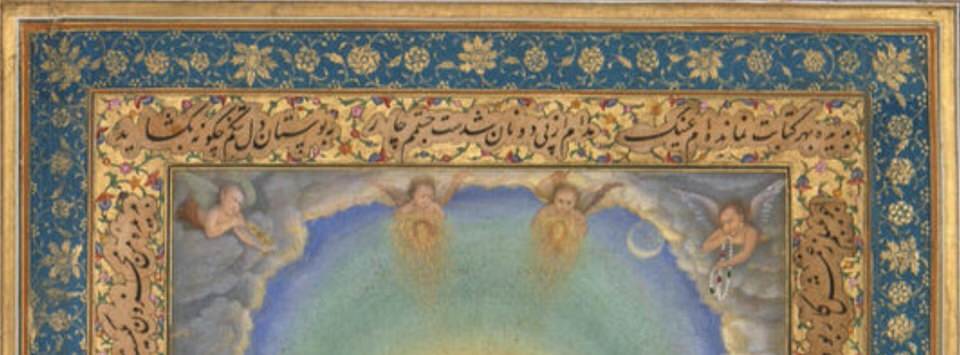
Chitarman has painted the new emperor as an icon of stability. His pose is formal, stiff. The depiction in profile gives him the bearing of someone standing apart from the world. His chest is garlanded with jewels: strings of fat pearls interrupted by rubies and emeralds. An advertisement of wealth, though scholars have observed religious significance: A young Muslim man would wear strands like this at his wedding. Shah Jahan is wearing a weighty pink coat, called a jama, festooned with flowers, belted with a sash of gold and orange. The coat is tied to the right, in Muslim fashion. (Hindus tied theirs to the left.)
On his head is a purple turban, strung with more jewels and topped with peacock feathers. That bird was an emblem: In the year this was painted, Shah Jahan ordered up the stupefyingly ornate Peacock Throne, whose jewels are now dispersed. Behind him is a marble screen, called a jali: an archetype of Indo-Persian luxury. The screen, as well as the floral-patterned brocade draped over its center, would have been made in one of the many imperial workshops. A painting like this would also have been the product of many hands.
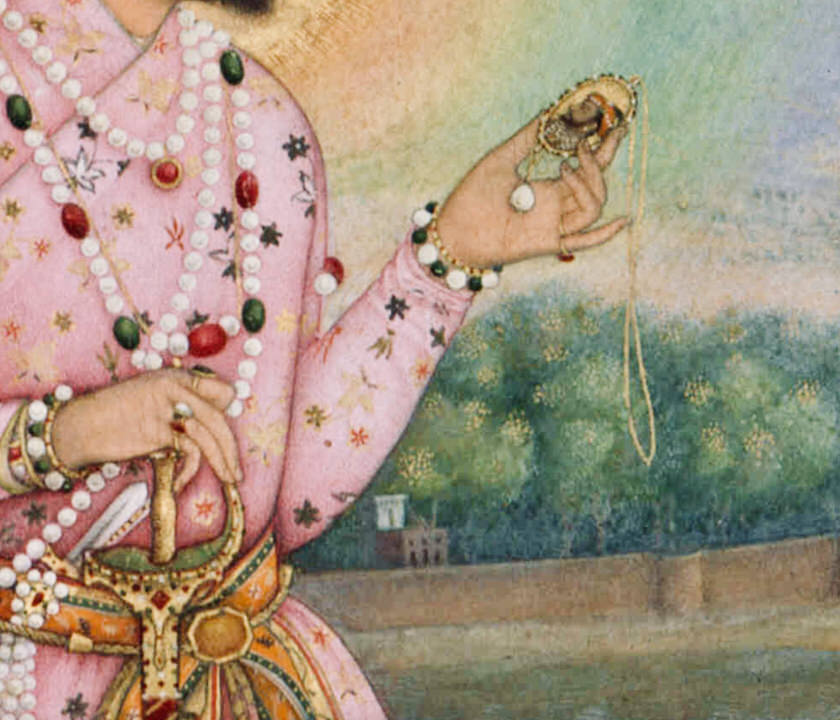
Chitarman would have designed the composition, selected the colors; then apprentices did the painstaking work, with fine brushes of squirrel hair. But this was court art, and the emperor tightly controlled his artists’ production. He ordered them to depict him in profile only, and as buffed and radiant as those emeralds and rubies. It’s a picture as beautiful and crisp as Shah Jahan’s Koh-i-Noor diamond. But its beauty was not an expression of vanity. It carried a clear political meaning: Here, I am king. India had a tradition of miniature painting before the Mughals.
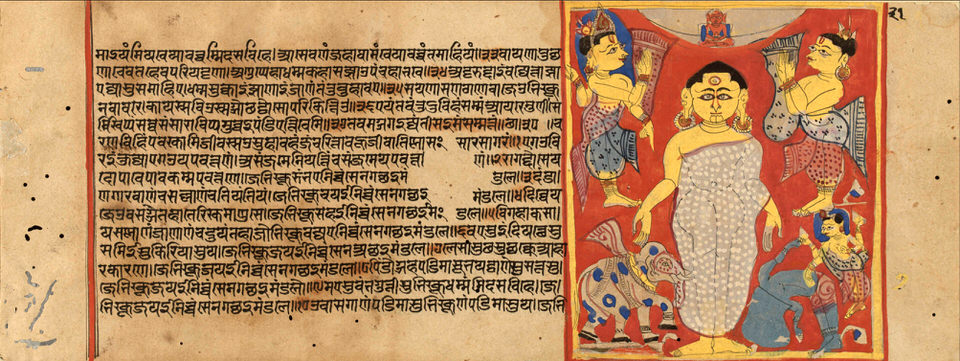
“Uttaradhyayanasutra,” Circa 1460/Victoria and Albert Museum; Bhairavi Ragini Circa 1520-1540/Victoria and Albert Museum
In the 11th century, Jain artists started to illustrate manuscripts such as these, with stylized scenes of monks and gods, men and elephants. Buddhism, born in India, generated illustrated scriptures, too. Hindu paintings, like this one of a worshipper of Shiva, emerge a little later. The artists favored bounteous colors that filled whole blocks of the page. The figures were simplified, and flush with the backgrounds.
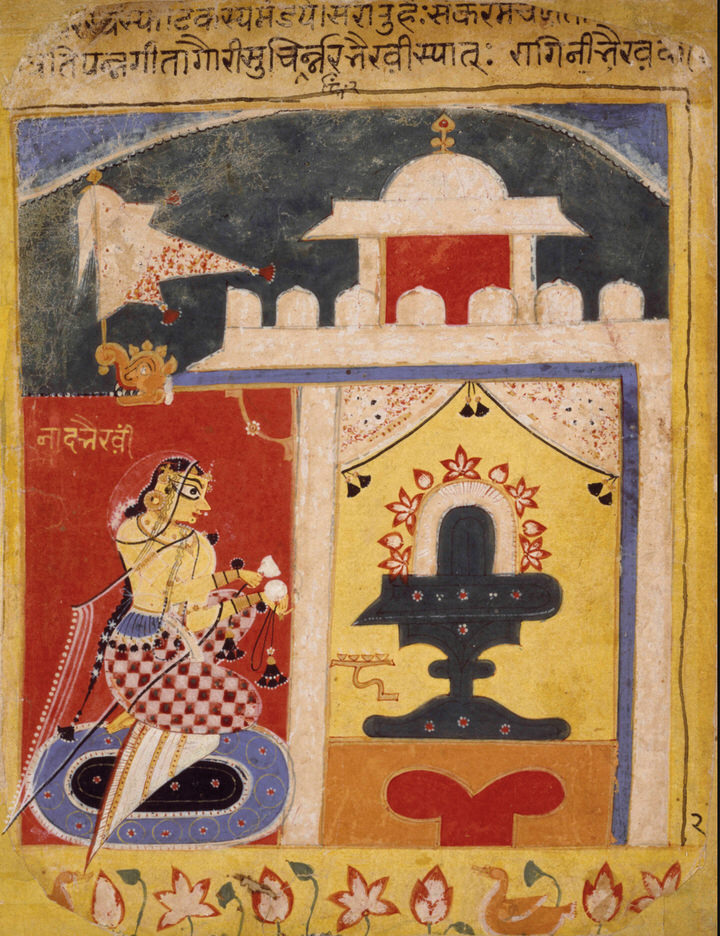
Sultan ’Ali al-Mashhadi and Zain al-’Abidin al-Tabrizi - “Illuminated Frontispiece of a Manuscript of the Mantiq al-tair” 1487 and illumination circa 1600/Metropolitan Museum of Art
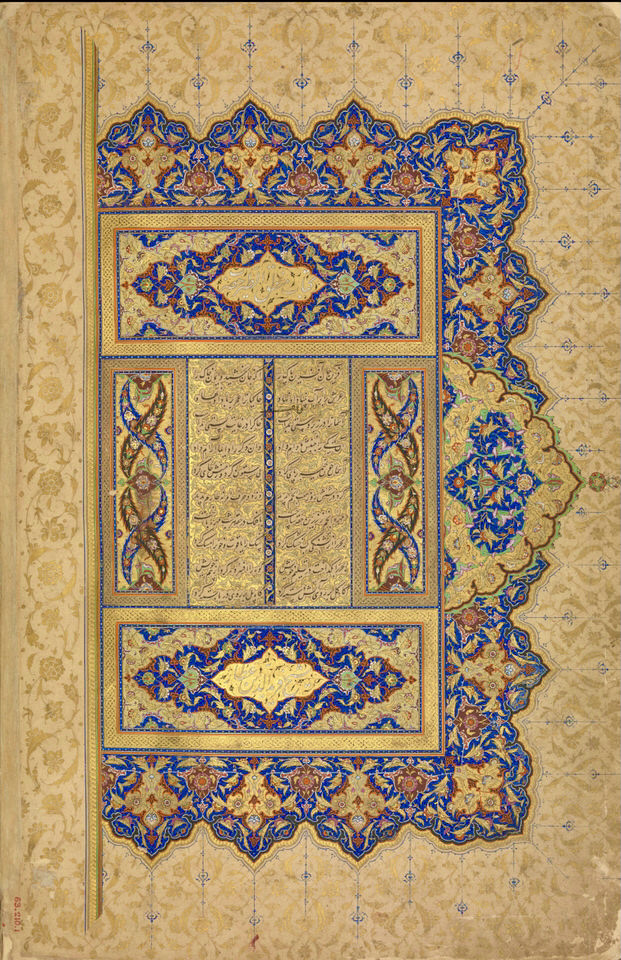
But soon Indian artists would encounter another tradition of immense refinement, from a faraway source. That source was Persia. In the 14th and 15th centuries, artists and scribes from Iran and Central Asia crafted manuscripts of astonishing intricacy. The details expressed their patrons’ religious piety, as well as their earthly wealth.
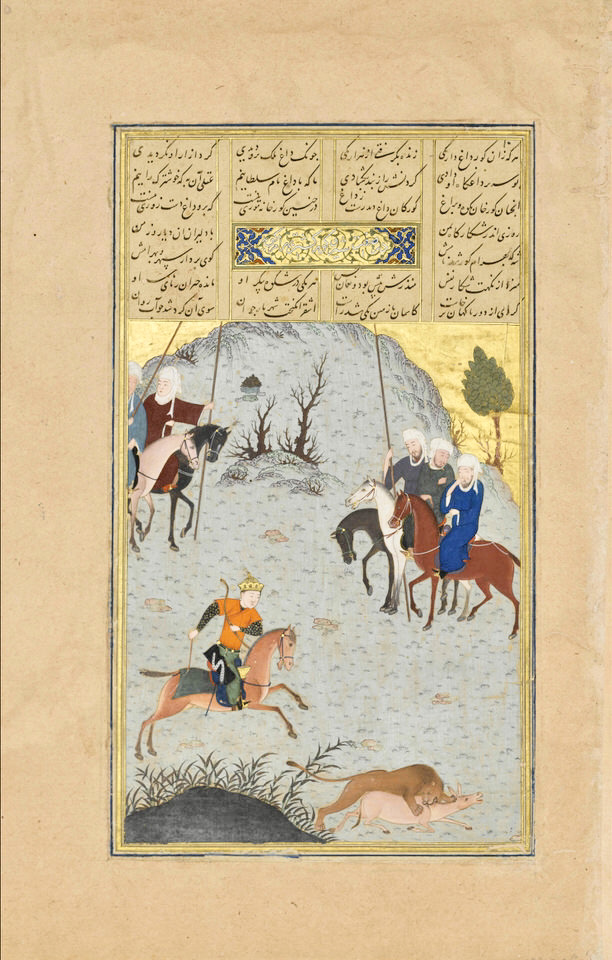
Nizami and Maulana Azhar, “Bahram Gur on the Chase,” circa 1430/Metropolitan Museum of Art
Persian artists of the Timurid dynasty also painted figures ... with gemlike watercolors and precisely drawn lines. Elsewhere, Muslim artists abjured images. In Central Asia, however, they depicted lovers in gardens or princes on horseback. Some even pictured Muhammad himself.
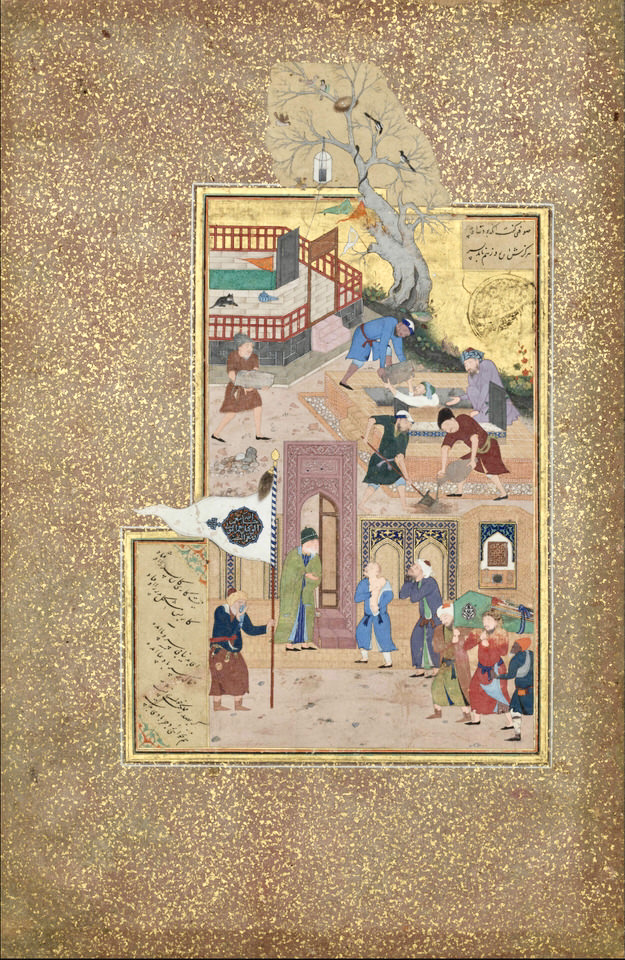
Sultan ’Ali al-Mashhadi and Farid al-Din ’Attar, “Funeral Procession,” 1487/Metropolitan Museum of Art
Indian miniaturists studied these imported Timurid manuscripts. When armies from Central Asia conquered the subcontinent’s north, expat Persian artists quickly followed. Local artists picked up new skills ... and rethought old styles.
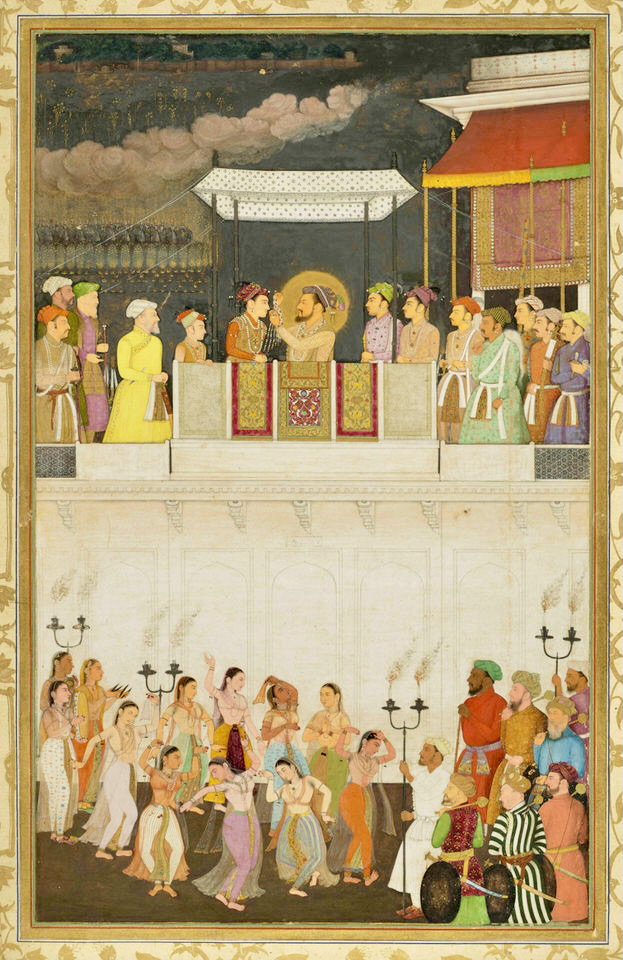
Bulaqi, “Shah-Jahan honouring Prince Dara-Shikoh at his wedding February 12,1633” 1656-57 Royal Collection Trust and Her Majesty Queen Elizabeth II
In the course of the 16th century, as the Mughal empire grew richer and more stable, a whole new kind of art came into being. Artists wed Persian line to Indian color, and imbued the liveliness of local painting with a stunning new exactitude. Mughal artists made ever more refined compositions to win the emperors’ favor. Sunni Muslims in a Hindu-majority country, these rulers needed new images of power and benevolence. They hired hundreds of artists, from India and abroad. Muslims and Hindus worked side by side. Hindu artists, in fact, became some of the most acclaimed artists at this Muslim court. The Mughals, at least at this point, had a policy of religious tolerance — just as Europeans were slaughtering one another in wars of religion.
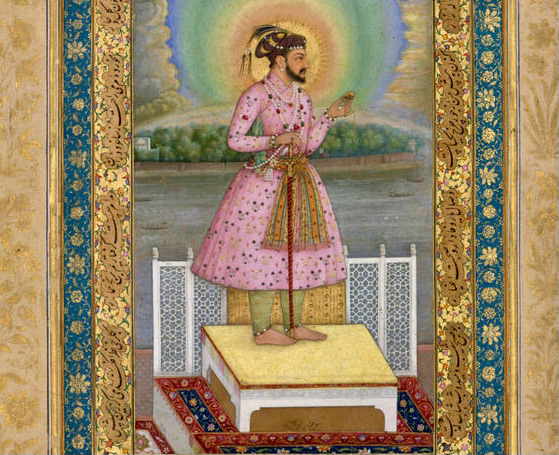
And these cross-faith encounters, by Shah Jahan’s time, had produced a radiant cross-cultural art. Chitarman, who painted this miniature, was a Hindu. Yet look at the rest of the sheet. This Hindu artist’s painting is bounded by Persian calligraphy: a melancholy epigram by a poet from Afghanistan. The poem forms a border between the emperor’s portrait and the floral profusion on the paper’s edges. The verses have nothing to do with Shah Jahan as such. They’re an expression, rather, of imperial connoisseurship.
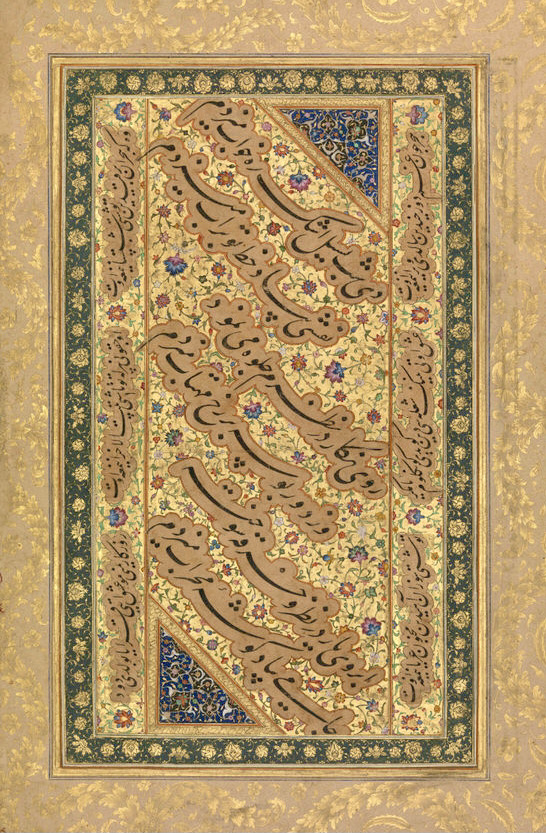
"Rosette Bearing the Names and Titles of Shah Jahan," recto: circa 1645 Verso: Circa 1630-40/Metropolitan Museum of Art
And if you flip the page over ... you’ll see the same blue and gold borders framing more calligraphy, written a hundred years earlier. This is also Persian verse, by a poet aching with love for a young friend. Shah Jahan’s workshop glued it on the painting’s back, following his tastes and maybe his direct command.
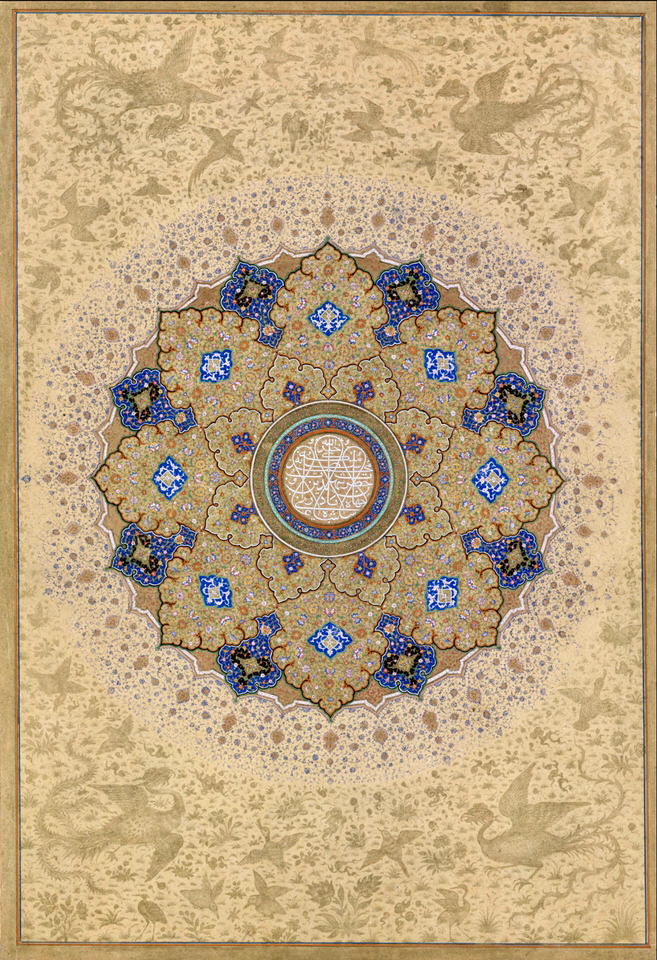
"Rosette Bearing the Names and Titles of Shah Jahan," recto: circa 1645 Verso: Circa 1630-40/Metropolitan Museum of Art
The page would have been sewn into a custom album — or muraqqa, in Persian. These were, essentially, glamorous scrapbooks. Most of them opened with an inscription, set in a decorative rosette. This one, dizzyingly intricate, places Shah Jahan’s many titles amid floral loops and arabesques.
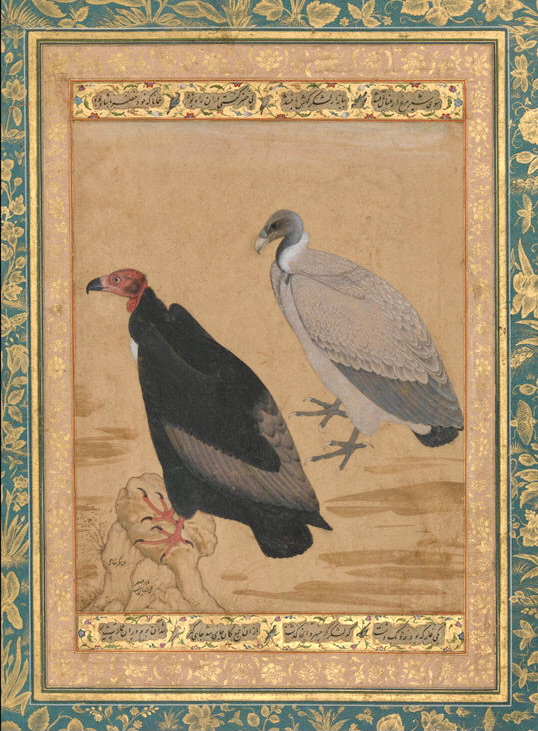
Mansur, “Red-Headed Vulture and Long-Billed Vulture” Circa 1615-20/Metropolitan Museum of Art
The ruler, or someone else in the Mughal elite, acted as curator. Artists gathered the materials ... pasted them onto cards, and ringed them in decorative frames. Shah Jahan’s, befitting the anthomaniac emperor, are drenched in gold flowers.
Hinduism and Islam were not the only two religious traditions to inform Mughal painting. Have a look at the soft rings of gold and green around the emperor’s head. This aureole of wealth and glory looks a bit like the gold halos of Christian saints?
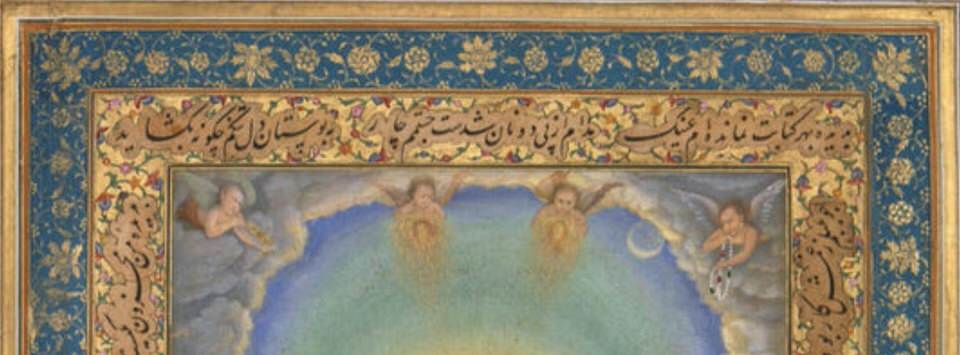
This trading empire was, indeed, in frequent contact with Christians. The Mughals sent ambassadors to Portuguese Goa, and welcomed Jesuit missionaries to court.
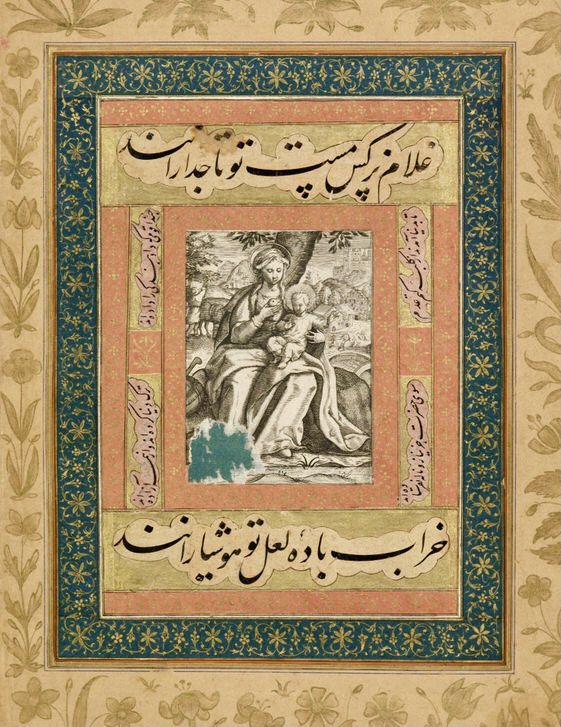
Dara Shikoh/British Library;
Those Europeans came with art of their own. Dutch and Flemish prints were particularly prized at the Mughal courts, and artists pasted them into the imperial albums.
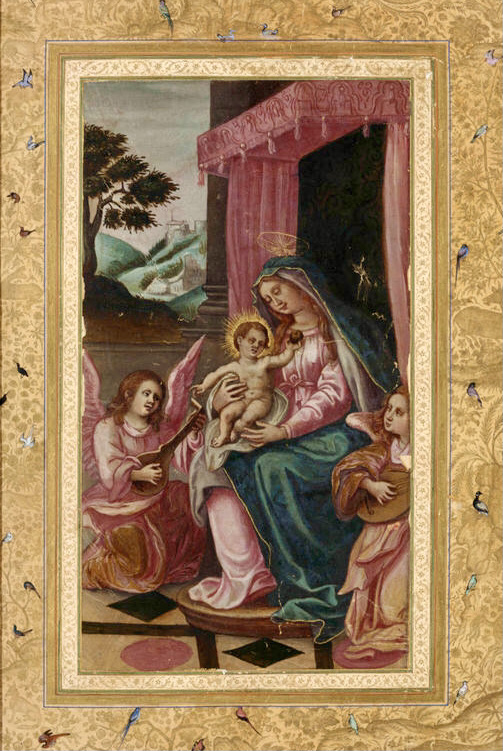
“Virgin and Child with Angels” Circa 1595-1600/President and Fellows of Harvard College
The rulers instructed their artists to copy European images. Mughal workshops quickly mastered Renaissance innovations in perspective and shading.

Portrait of Shah Jahan, circa 1610-1630/Victoria and Albert Museum
Mughal artists didn’t so much imitate European examples as selectively incorporate them. Renaissance naturalism commingled with Persian and Indian forms.

Rembrandt van Rijn - “Shah Jahan” Circa 1656-1661/Cleveland Museum of Art
The traffic went back and forth. When English and Dutch traders returned home, laden with spices and textiles, they told over-the-top tales of the elegance of the Mughals. Their wealth entered the language: “Mogul” still means power player.
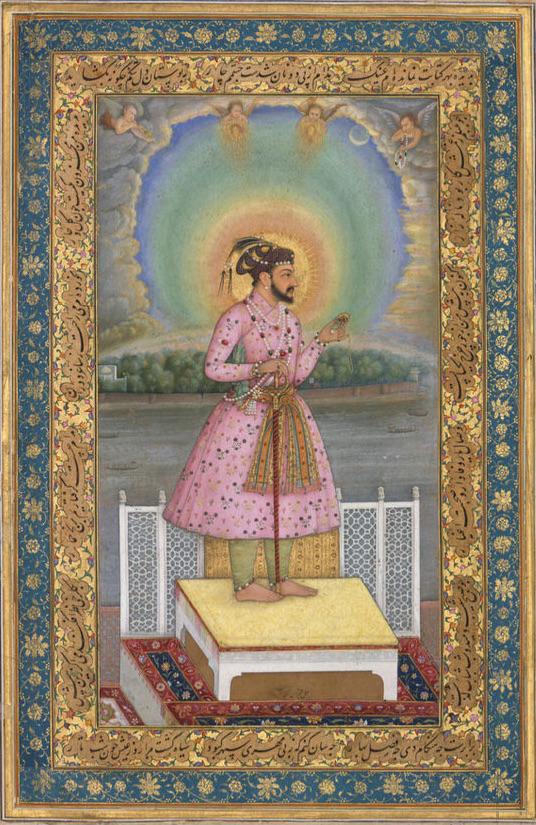
Some European artists found the splendor of the Mughals irresistible. This drawing of Shah Jahan is by none other than Rembrandt, all the way in Amsterdam. None of it came cheap, nor did the wars he waged. And not all his coreligionists were pleased. The son who succeeded him, in a bloody struggle, was a Muslim fundamentalist who cared little for the arts. He closed the imperial painting workshops. The years to come saw war, despotism, famine and plague.
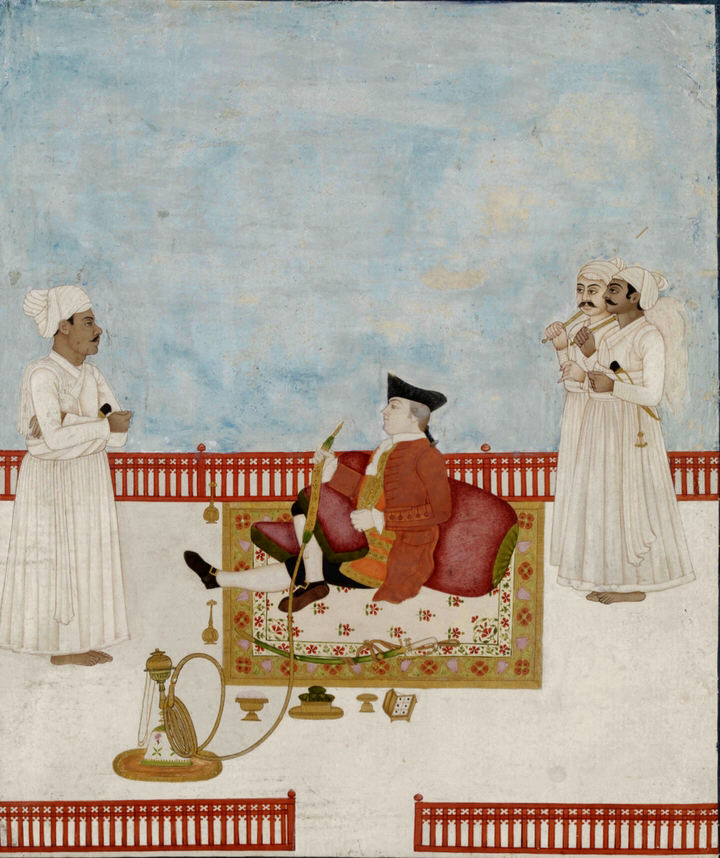
Dip Chand - Portrait of East India Company official Circa 1760-1764/Victoria and Albert Museum
In the 18th century, the Mughal empire went into decline. Decade by decade the merchants of the East India Company expanded their dominion. By 1858, the British crown took over. The Mughal empire faded away, though not its allure. The colonists of the Raj fell hard for the romance of the vanished Mughals — and one of Shah Jahan’s works in particular.

“The Western Building, Tal Mahal in Agra,” 1900-05/Royal Collection Trust and Her Majesty Queen Elizabeth II
A few years after Chitarman’s portrait of Shah Jahan was completed, the emperor ordered the erection of a mausoleum for his favorite wife. It was to be covered in white marble from Rajasthan, with a mosque standing alongside. The design of the Taj Mahal is as formal, as precise, and as culturally hybrid as the portrait. Persian and Indian motifs blend into one another. It took decades of work. Architects, masons, mosaicists, calligraphers. Indians, Persians, Europeans. A thousand elephants to haul in the stone. Shah Jahan would eventually be interred here alongside his wife, in a tomb garlanded with flowers of precious stones. The haughtiest of rulers would be remembered best as the author of a marble love story. The Taj Mahal proved irresistible to foreigners. Like the woman who pasted these photographs in another imperial album: Mary of Teck, who was both queen of England and empress of India.

But the mausoleum, like the albums, was much more than a personal luxury. Shah Jahan and his artists knew that if you really want to wield political power, you need more than soldiers or imams. Power, for the Mughals, also came from absorbing the cultural forms under their authority, then reconstituting them in their own image. In Shah Jahan’s left hand is a pendant, circled with even more jewels. Strung with a chain of gold, suffixed with a teardrop-shaped pearl. Set into the pendant is a cameo. It’s a detail that could have been included at the emperor's command. Maybe it’s another foreign luxury, or the work of a European lapidary at the Mughal court, carving Asian precious stone. But real or imagined, Indian or otherwise, the cameo’s subject is undeniable: It’s Shah Jahan. A miniature in a miniature, a painting made from a gem. As lavish and cold as the ruler it depicts. We behold the emperor beholding himself, contemplating his own magnificence.

The image of authority can be as big as the Taj Mahal, or so small it fits in your hand. The challenge, for emperor or artist, is to make that image stick. You can have sway in the short term through your army and your treasury. But if you want to last forever, make something beautiful.

